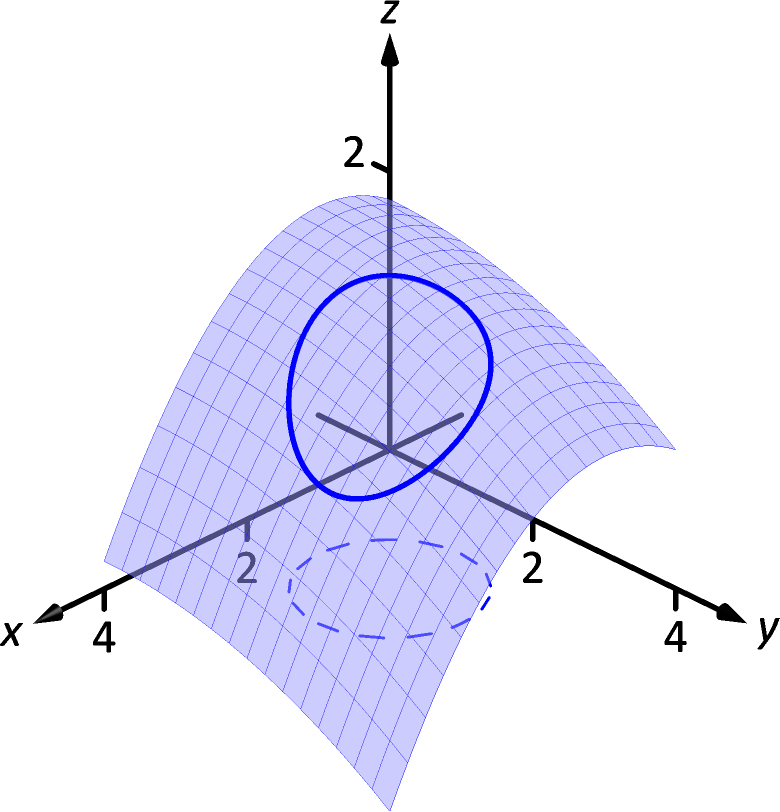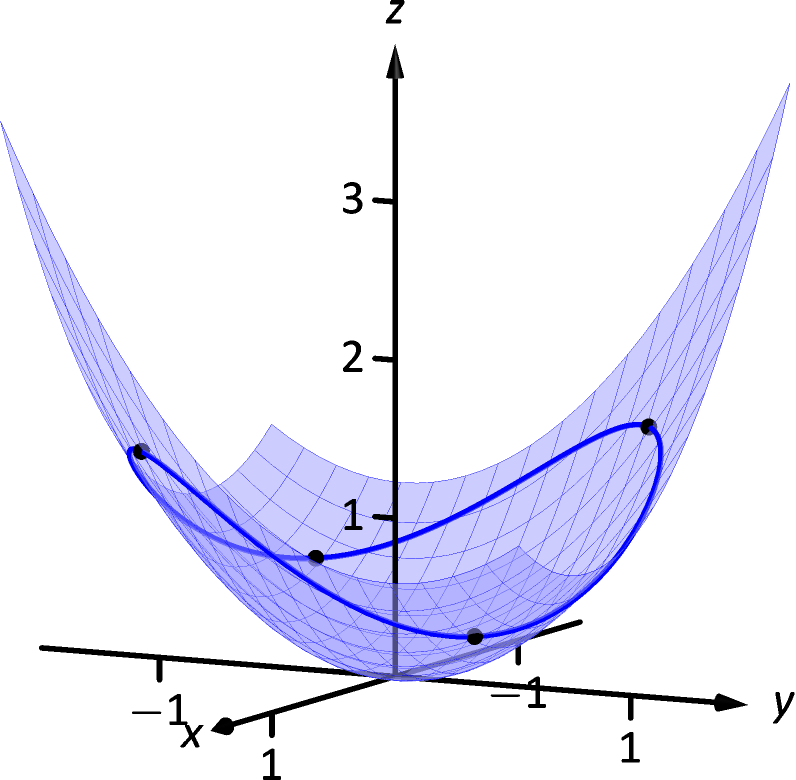13.5 The Multivariable Chain Rule
The Chain Rule, as learned in Section 2.5, states that . If , we can express the Chain Rule as
In this section we extend the Chain Rule to functions of more than one variable.
Theorem 13.5.1 Multivariable Chain Rule, Part I
Let , and , where , and are differentiable functions. Then is a function of , and
-
Proof
By definition,Let
Because is differentiable, Definition 13.4.2 gives us functions and so that
This means that
It is good to understand what the situation of , and describes. We know that describes a surface; we also recognize that and are parametric equations for a curve in the - plane. Combining these together, we are describing a curve that lies on the surface described by . The parametric equations for this curve are , and .
 Figure 13.5.1: Understanding the application of the Multivariable Chain Rule.
Figure 13.5.1: Understanding the application of the Multivariable Chain Rule.
Consider Figure 13.5.1 in which a surface is drawn, along with a dashed curve in the - plane. Restricting to just the points on this circle gives the curve shown on the surface. The derivative gives the instantaneous rate of change of with respect to . If we consider an object traveling along this path, gives the rate at which the object rises/falls.
We now practice applying the Multivariable Chain Rule.
Example 13.5.1 Using the Multivariable Chain Rule
Let , where and . Find using the Chain Rule.
SolutionFollowing Theorem 13.5.1, we find
Applying the theorem, we have
This may look odd, as it seems that is a function of , and . Since and are functions of , is really just a function of , and we can replace with and with :
The previous example can make us wonder: if we substituted for and at the end to show that is really just a function of , why not substitute before differentiating, showing clearly that is a function of ?
That is, Applying the Chain and Product Rules, we have
which matches the result from the example.
This may now make one wonder “What’s the point? If we could already find the derivative, why learn another way of finding it?” In some cases, applying this rule makes deriving simpler, but this is hardly the power of the Chain Rule. Rather, in the case where , and , the Chain Rule is extremely powerful when we do not know what , and/or are. It may be hard to believe, but often in “the real world” we know rate-of-change information (i.e., information about derivatives) without explicitly knowing the underlying functions. The Chain Rule allows us to combine several rates of change to find another rate of change. The Chain Rule also has theoretic use, giving us insight into the behavior of certain constructions (as we’ll see in the next section).
We demonstrate this in the next example.
Example 13.5.2 Applying the Multivariable Chain Rule
An object travels along a path on a surface. The exact path and surface are not known, but at time it is known that :
Find at time .
SolutionThe Multivariable Chain Rule states that
By knowing certain rates-of-change information about the surface and about the path of the particle in the - plane, we can determine how quickly the object is rising/falling.
We next apply the Chain Rule to solve a max/min problem.
Example 13.5.3 Applying the Multivariable Chain Rule
Consider the surface , a paraboloid, on which a particle moves with and coordinates given by and . Find when , and find where the particle reaches its maximum/minimum -values.
SolutionIt is straightforward to compute
Combining these according to the Chain Rule gives:
When , and . Thus . When , the particle is moving down, as shown in Figure 13.5.2.
 Figure 13.5.2: Plotting the path of a particle on a surface in Example 13.5.3.
Figure 13.5.2: Plotting the path of a particle on a surface in Example 13.5.3.
To find where -value is maximized/minimized on the particle’s path, we set and solve for :
We can use the First Derivative Test to find that on , has reaches its absolute minimum at and ; it reaches its absolute maximum at and , as shown in Figure 13.5.2.
We can extend the Chain Rule to include the situation where is a function of more than one variable, and each of these variables is also a function of more than one variable. The basic case of this is where , and and are functions of two variables, say and .
Theorem 13.5.2 Multivariable Chain Rule, Part II
-
1.
Let , and , where , and are differentiable functions. Then is a function of and , and
-
•
, and
-
•
-
•
-
2.
Let be a differentiable function of variables, where each of the is a differentiable function of the variables . Then is a function of the , and
The proof of Part II follows quickly from Part I, because means that we hold the other variables constant and we are back to the one variable case already proved. A helpful way to remember the derivatives is to examine the following chart
Each possible path from to the variable contributes a term to the sum, and each line segment in a path contributes a factor to that term.
Watch the video:
Generalized Chain Rule — Part 1 from https://youtu.be/HOYA0-pOHsg
Example 13.5.4 Using the Multivariable Chain Rule, Part II
Let , and . Find and , and evaluate each when and .
SolutionFollowing Theorem 13.5.2, we compute the following partial derivatives:
Thus
When and , and , so
Example 13.5.5 Using the Multivariable Chain Rule, Part II
Let , where , , and . Find when and .
SolutionFollowing Theorem 13.5.2, we compute the following partial derivatives:
Thus
When and , we have , and . Thus
Implicit Differentiation
We studied finding when is given as an implicit function of in detail in Section 2.6. We find here that the Multivariable Chain Rule gives a simpler method of finding .
For instance, consider the implicit function We learned to use the following steps to find :
| (13.2) |
Instead of using this method, consider . The implicit function above describes the level curve . Considering and as functions of , the Multivariable Chain Rule states that
| (13.3) |
Since is constant (in our example, ), . We also know . Equation (13.3) becomes
Note how our solution for in Equation (13.2) is just the negative of the partial derivative of with respect to , divided by the partial derivative of with respect to .
We state the above as a theorem for two and three variables.
Theorem 13.5.3 Implicit Differentiation
If is a differentiable function of and , where defines as an implicit function of for some constant , then
If is a differentiable function of , , and , where defines as an implicit function of and for some constant , then
We practice using Theorem 13.5.3 by applying it to a problem from Section 2.6.
Example 13.5.6 Implicit Differentiation
Given the implicitly defined function , find . Note: this is the same problem as given in Example 2.6.4 of Section 2.6.
SolutionLet ; the implicitly defined function above is equivalent to . We find by applying Theorem 13.5.3. We find
so
which matches our solution from Example 2.6.4.
Exercises 13.5
Terms and Concepts
-
1.
Let a level curve of be described by , . Explain why .
-
2.
Fill in the blank: The single variable Chain Rule states .
-
3.
Fill in the blank: The Multivariable Chain Rule states .
-
4.
If , where and , we can substitute and write as an explicit function of . T/F: Using the Multivariable Chain Rule to find is sometimes easier than first substituting and then taking the derivative.
-
5.
T/F: The Multivariable Chain Rule is only useful when all the related functions are known explicitly.
-
6.
The Multivariable Chain Rule allows us to compute implicit derivatives easily by just computing two derivatives.
Problems
In Exercises 7–12, functions , and are given.
-
(a)
Use the Multivariable Chain Rule to compute .
-
(b)
Evaluate at the indicated -value.
-
7.
, , ;
-
8.
, , ;
-
9.
, , ;
-
10.
, , ;
-
11.
, , ;
-
12.
, , ;
In Exercises 13–18, functions , and are given. Find the values of where . Note: these are the same surfaces/curves as found in Exercises 7–12.
-
13.
, ,
-
14.
, ,
-
15.
, ,
-
16.
, ,
-
17.
, ,
-
18.
, ,
In Exercises 19–22, functions , and are given.
-
(a)
Use the Multivariable Chain Rule to compute and .
-
(b)
Evaluate and at the indicated and values.
-
19.
, , ; ,
-
20.
, , ; ,
-
21.
, , ; ,
-
22.
, , ; ,
In Exercises 23–26, find using Implicit Differentiation and Theorem 13.5.3.
-
23.
-
24.
-
25.
-
26.
In Exercises 27–30, find , or and , using the supplied information.
-
27.
, , ,
-
28.
, , ,
-
29.
, ,
, , ,
-
30.
, ,
, , ,
-
31.
Suppose is differentiable. Express in polar coordinates as , . Calculate .
-
32.
Suppose is differentiable. Express in spherical coordinates as , , . Calculate .
-
33.
Suppose the radius of a circular cylinder is increasing at the constant rate of cm/sec while its height is decreasing at the rate of cm/sec. How is the volume of the cylinder changing when the radius cm and the height is cm?
